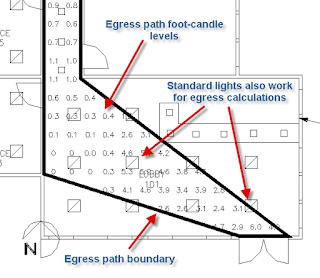- Basic Technical Terms of Lighting
- Formulas for calculations
- Step-by step method for calculating Lux level in a room
- Case Study
- Lamp Data - for a lighting Designer
- Light Fixture data - for a lighting Designer
- Day Lighting - Factors
Basic Technical Terns of Lighting Design
Flow of Light can be compared with the flow of water
quantity
|
symbol
|
unit
|
Description
|
Example
| ||
luminous flux
|
Φ
|
lumen (lm)
|
total quantity of light emitted per second by a light source
|
quantity of water passing a given point per second
| ||
luminous intensity
|
I
|
candela (cd)
|
concentration of light in a specific direction, radiated per second
|
intensity of a water jet in a given direction.
| ||
illuminance
|
E
|
lux (lx)
|
quantity of light, or luminous flux, falling on a unit area of a surface
|
amount of (rain)water falling on an area of surface per sec.
| ||
luminance
|
L
|
Candela/Sq Mtr (cd/m2)
|
luminous intensity emitted per Unit of area of a surface in a specific direction
| |||
Efficacy
|
lumens per watt
|
The ratio of lamp luminous flux divided by the power consumed by the lamp
|
Where control gear is taken into account the unit becomes lumens per circuit watt.
| |||
COLOUR RENDERING INDEX (CRI) (of a lamp) - Is a measure of a lamp's colour rendering ability.
COLOUR TEMPERATURE (of a light source) - The temperature of a black body which emits radiation of the same chromaticity as the light source being considered.
Interior Lighting Calculation
Formulas for calculations
F = initial lamp lumens
L = length of room
K =Room Index
N = number of luminaires
UF = utilisation factor
W = width of room
D = Distance between light source and work plane
Hm = height of luminaire above working plane
MF = maintenance factor
How to calculate illuminance?
(F x n x N x MF x UF)
E = ------------------------------
A
How to calculate average illuminance in a room?
lm
E(AV) = -----------
d x d
How to calculate Room Index?
This takes account of room proportions and height of the luminaire above the
working plane. It is used to determine the Utilization factor.
L x W
K =------------------
(L + W) x Hm
How to calculate average maintenance factor a room?
MF = LLMF x LSF x LMF x RSMF
lm
I = ----------
4 x 3.1
LLMF = Lamp lumen maintenance factor - the reduction in lumen output after specific burning hours
LSF = Lamp survival factor - the percentage of lamp failures after specific burning hoursLMF = Luminaire maintenance factor - the reduction in light output due to dirt deposited on or in the luminaire
RSMF = Room surface maintenance factor - the reduction in reflectance due to dirt deposition in the room surfaces
Step-by Step Method of lighting Design
1. Details required - Length, Ht, Required lux level, details of light fixture, Maintenance and Utility factor
2. Calculate the Lux level requirement
Case Study:-
Example 1.1
The illuminance (E) on the working plane is 500 lux.The reflectance is 50%, calculate the luminance of the working plane.
L = E x R(p.u.)
= 500 x .5 = 250 Apostilbs
= 250 / 3.14 = 80 cd/m2
Lamp Data for Lighting Designer
1. Initial Lumen Output - Lamp Output after 100Hours
2. Lighting Design Lumen Output - After 2000 Hours
3. Color Temperature
4. Color Rendering Index & Color Rendering Group
5. Physical Dimensions
6. Ballast Type - (Standard, Program Start etc, Electronic, etc)
7. Power Rating
Light Fixture Data for Lighting Designer
1. Photometric data
2. Space to Height ratio.
3. Utilization factor
4. Electrical Specifications
5. Mechanical Specifications
Day Light Advantages comparing to artificial light
1. Healthier and more satisfactory
2. Economic advantage
3. Good Color rendering.




